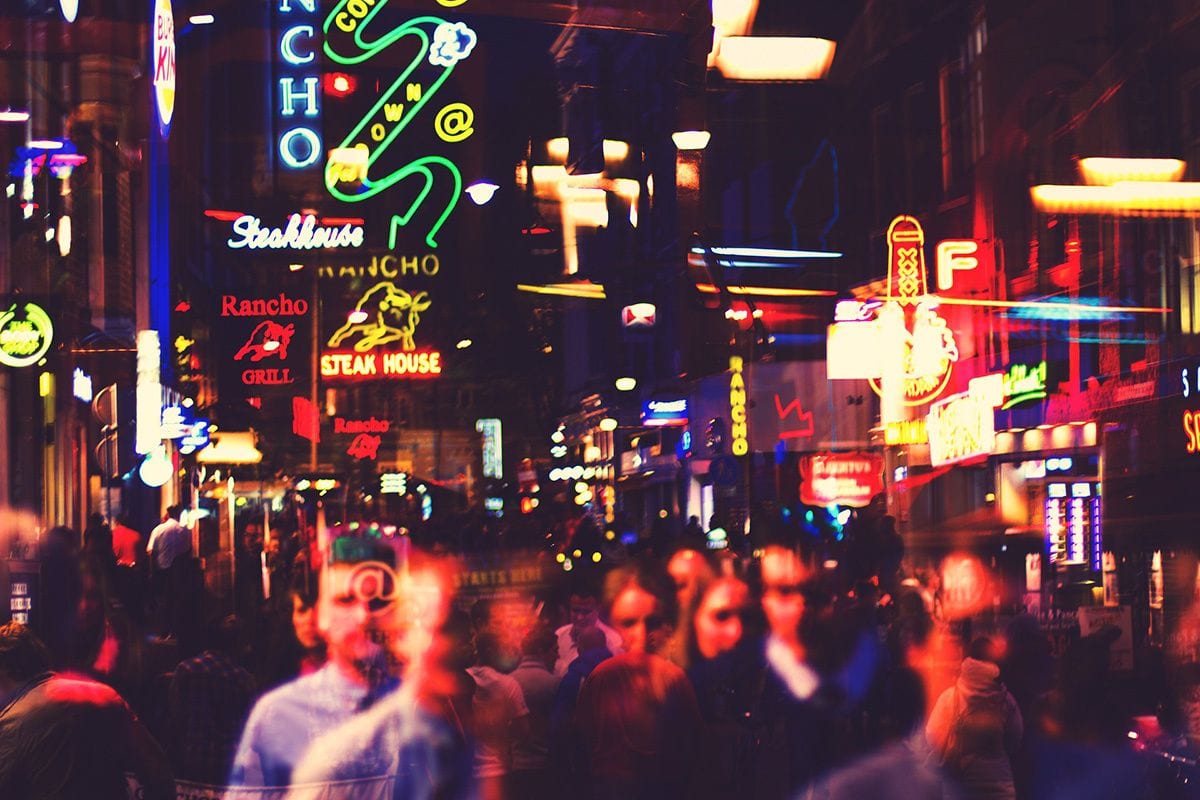
Luis de Miranda‘s work sits at the intersection of philosophy and history, which is where we find Being and Neonness, translated by Michael Wells for a new 2019 edition. De Miranda was inspired to consider the history of neon while living in Paris, where engineer Claude George invented the technology in 1912. The first edition of Being and Neonness was published in Paris and marked neon’s centennial anniversary.
The second edition evolved through conversations between Wells, a seasoned translator, and de Miranda, whose fluency in French and English enabled a more collaborative translation than is typical. The ten resulting essays that comprise the book are both contemplative and poetic, stretching far beyond a view of 100 years of bright lighting.
Neon signs have their origin in Paris, yet de Miranda argues that neon became iconic as an aesthetic representation of the United States. By mid-century, New York City’s Times Square was a gleaming array of neon, marking it a mecca for the bright, colorful lights. He turns to Tom Wolfe to describe Las Vegas as a city made not of buildings but of neon, creating an architecturally unified city of light.
Finally, de Miranda relates a story about Earle C. Anthony, who brought neon to the US from Paris. Anthony “put up a huge sign for the carmaker Packard on a Hollywood boulevard, which was so stupefying in its novelty that for the first few months it caused accidents and traffic jams and elicited the helpless disapproval of the local police.” These instances of neon splendor were so widely known worldwide that cultural centers in Soviet bloc cities also became flush with neon lights to compete aesthetically with capitalist cities in the West.
Being and Neonness is in part a critique of capitalism and its impact on creativity. De Miranda points out that nighttime lighting, appearing shortly before neon, expanded the timeframe for shopping and consumption beyond daylight hours. On one hand, shopping and being out in the city was a glamorous, social activity, if we consider Baudelaire’s flaneur and Walter Benjamin’s arcades. On the other hand, shopping is a manifestation of the scourge of capitalism. “In the twentieth century,” de Miranda adds, “controlling light meant controlling society through consumption, and this is still true today through the light of our computer or phone screen.”
If neon was an icon of mid-century capitalism, what does it represent in the period of late capitalism? Part of de Miranda’s project is to answer this question by using neon as a metaphor. The title deliberately brings to mind Jean-Paul Sartre’s Being and Nothingness (L’Etre et le Neant). De Miranda describes modernity and capitalism in part through an existential lens, acknowledging that each individual is defined by their own thoughts, often trapped between freedom and existential angst. In a conversation with translator Michael Wells, “Being & Neonness — Ten Questions to author Luis de Miranda”, Medium, May 2019) de Miranda says about the origins of Being & Neonness:
“I felt quite alone in those days, back in 2011; living in Paris was starting to feel like a dead end, a nauseous repetition without much novelty, nothingness. I started researching the history of neon, and a few months later began giving a weekly seminar in the medieval basement of the Café des Fous, a bar in the St-Germain des Près neighborhood. I would read drafts of the book, accompanied by guest artists.”
The powerful sense of place that permeates Being and Neonness is present in this conversation as well. De Miranda’s careful attention to detail creates vivid landscapes that lean toward the poetic. Neon is specifically related to place in the naming of red light districts, where one can find strip clubs and brothels. Moving toward the end of the 20th century, de Miranda notes the feeling that neon is aesthetically stretched far beyond vulgar red light districts. In a nostalgic revival, the celebrated midcentury design returned in the form of quaint and amusing (e.g., retro). Globally, neon signs “sometimes seem to maintain a hybrid status, somewhere between junkyards and museums, not unlike Eurpoean capitals themselves.”
The essays in Being and Neonness reach far beyond a history of bright urban lights, yet de Miranda regularly recalls neon as metaphor, a connection addressed throughout the book. He ends on a positive note, with discussion of an art installation in Paris in the aftermath of the May 1968 uprisings. In the gallery, a naked man was encased in a cage of fluorescent tubes, a kind of “neon prison” in which the young man and visitors gazed at one another. What if, de Miranda proposes, those vertical bars of light were arranged horizontally instead of vertically? They would become “steps we can climb to explore the unheard regions of our cosmos.” Rather than surveilling and being surveilled, we can use neon, metaphorically, to shine the light on brighter futures.
Being and Neonness is a slim, bright volume that demands a contemplative approach. The reader will be rewarded for taking time with this collection of essays.

